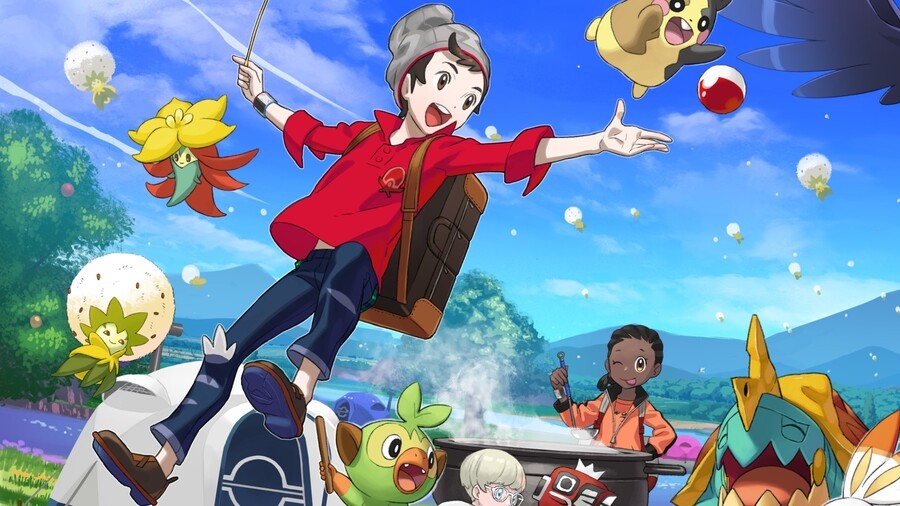
Six years ago, running up to Pokémon’s 20th anniversary, we did a rundown of each of the generations of Pokémon, and then brought it back three years ago to cover Generation 7.
Now, we’re truly in the news cycle for Generation 9's Pokémon Scarlet & Violet, so it’s time to take a look back at the last three years, the eighth generation of Pokémon, which covers one of the most divisive times Pokémon has ever seen...
- Generation 7 - 2016 To 2019
- Generation 6 - 2013 To 2016
- Generation 5 - 2010 To 2013
- Generation 4 - 2006 To 2010
- Generation 3 - 2002 To 2006
- Generation 2 - 1999 To 2002
- Generation 1 - 1996 To 1999
Subscribe to Nintendo Life on YouTube841k
A Pokémon Retrospective: Generation 8 – 2019 To 2022
The Build-Up
It all began on Pokémon Day in 2019. Following on from 2018's Pokémon: Let's Go, Pikachu! and Let's Go, Eevee!, a Pokémon Direct was broadcast that focused solely on one trailer and that trailer showcased the first footage of the first brand new Pokémon game for the Nintendo Switch, Pokémon Sword & Shield.
In many ways, the build-up contained some of the more imaginative reveals. While The Pokémon Company toned down on the quantity of reveals, it really increased the style and methods. While you had the usual Nintendo Direct reveals or Pokémon World Championships reveals, there are two other big reveal methods of note. In September, there was an 'issue' where Rotom corrupted the official website and had a distorted image on it. This storyline led to the reveal of Sirfetch’d. And in October, TPC held a 24-hour nature livestream set in Glimwood Tangle to eventually reveal the new form, Galarian Ponyta.
However, all was not well with this cycle. Following the second Pokémon Direct and near-unanimous positive reception of Pokémon Sword & Shield reveal, in one fateful E3 Treehouse segment the news dropped that not all Pokémon would be coded within the game and thus couldn’t be caught or transferred within. This created a very loud wave in the community with YouTubers and people on socials creating campaigns about it — arguably fuelled by misinformation and mistranslations distorting people’s disappointment in the decision — and resulted in people being far more critical of everything Pokémon than ever before. This even included harassment and threats against not just those in The Pokémon Company, but those in the Pokémon fandom. Thankfully, that has mostly subsided in the years since.
The Main Series
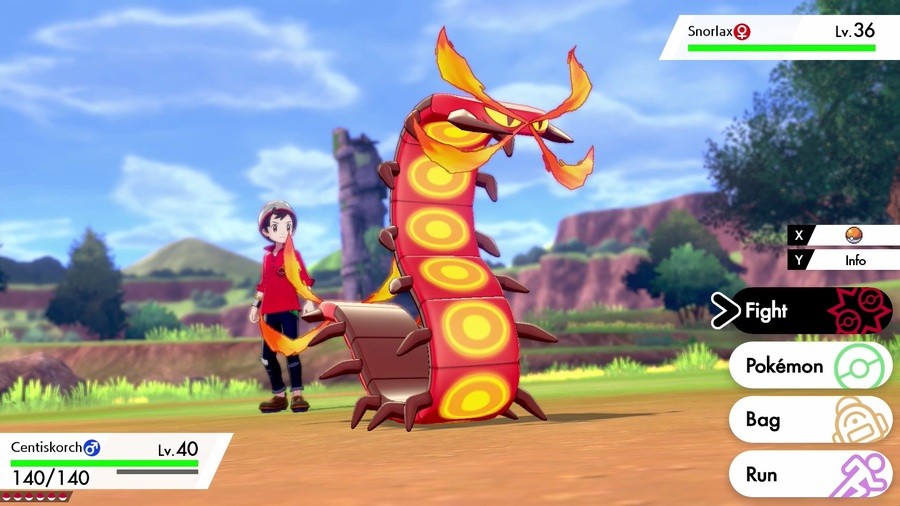
Generation 8 is actually quite unique in that its main series games are vastly different from each other.
The first main series game is Pokémon Sword & Shield, which released November 15th 2019 globally. This game was set in the Galar region, modelled after the UK, and had you play as a new trainer who participates in the Gym Challenge, a play on the sports-focused elements of the UK, and it then goes off the rails as the man who runs the Gym Challenge becomes obsessed with solving an issue that is thousands of years away. In total, by the end of the generation, Pokémon Sword & Shield introduced 89 new Pokémon. It has since become the second best-selling Pokémon game of all time.
Mechanically, this game introduces, Dynamax, which makes your Pokémon giant for three turns with special moves that have wide effects. This also ties into a new co-op feature, Max Raid Battles, a twist on the Raid Battles seen within Pokémon GO that has up to four players team up together to defeat a Dynamax Pokémon for various rewards and a chance to capture it.
The game also featured the first open areas of a Pokémon game, the Wild Area; while not a fully open world, this open area was split into segments with different Pokémon, and the Pokémon varied based on the weather. Throughout the open areas, you could find Pokémon Dens which could be used to start Max Raid Battles, and there were even frequent Max Raid Battle event distributions offering special themed event raids every few weeks throughout the three years of the generation.
In January of 2020, following the game’s launch, a Pokémon Direct was held which revealed that, for the first time in Pokémon history, rather than an enhanced version, Pokémon Sword & Shield would feature the first paid downloadable Expansion Pack, which would release in two parts throughout the year. This also coincided with patches for all players to add over 100 old Pokémon into the game. Even if you didn’t buy the DLC, you could trade with those who bought the DLC and caught them, participate in Raid Battles hosted by those who bought the DLC, or just transfer them in from past games.
The first of these DLC packs, The Isle of Armor, introduced various new Pokémon, specifically Kubfu and Urshifu, and had you go to the titular Isle of Armor where you get mistaken for a new entrant into the dojo. You get given a Kubfu and are told to train it. This was a far more detailed open area than the Wild Area and focused more on exploring and battling.
The second DLC pack was The Crown Tundra. This pack was more narrative-focused and took place in another open area that brought winding caves back. Here, you met the character Peony and investigated various Legendary clues throughout which lead you to discovering the story of Calyrex, the new Pokémon Regieleki & Regidrago, and the Galarian Forms of the Kanto Legendary trio Articuno, Zapdos, and Moltres. This pack also introduced an adaptation of Max Raid Battles called Dynamax Adventures where you go through a gauntlet of Dynamax Pokémon using Rental Pokémon to find a Legendary.
In 2021, everything changed when two more main series games were revealed at the same time. In a first for the franchise, a mainline series title was developed by a studio aside from Game Freak. Pokémon Brilliant Diamond & Shining Pearl are remakes of the original Diamond & Pearl and developed by the company ILCA in Japan. These games were very faithful to the originals and didn’t include many changes other than the inclusion of the battle system from Sword & Shield and some changes to the Underground and Contest systems.
However, Game Freak’s other main series title, Pokémon Legends: Arceus, is a massive change to everything that has come before in Pokémon. This game is set in Hisui, the region that became Sinnoh, and has you play as a teenager who got brought back in time by Arceus to help solve a crisis. The gameplay is very different and has you go through five open areas catching Pokémon and calming Noble Pokémon, giant Pokémon that have been sent berserk through various energy. The gameplay is different and has you able to throw PokéBalls at Pokémon in the overworld and has seamless battles with a simpler battle system compared to Sword & Shield. It also introduced a variety of new Pokémon, mostly evolutions of older Pokémon or special regional variants of older Pokémon.
The main series in Generation 8 was a massive shift. Pokémon Sword & Shield continued as the competitive game, even after the release of Brilliant Diamond & Shining Pearl and Legends: Arceus, and — without using Pokémon HOME — the three games are largely independent and separate, a marked change from all generations prior where the games were nearly fully interactive.
The Pokémon
Generation 8 brought in a total of 96 Pokémon into the fold. 81 in base Sword & Shield, eight in the DLC and a further seven in Pokémon Legends: Arceus. This was the highest number since the shift to 3D in Generation 6. It featured the return of Regional Variants in Galarian and Hisuian Forms and also added special forms given for various Pokémon when they Dynamax; Gigantamax Forms. These forms had no changes other than visuals and the special move used but over 30 Pokémon have Gigantamax forms.
The Starter Pokémon were the Grass-type Grookey, the Fire-type Scorbunny and the Water-type Sobble which just remained the same type as they evolved, a first for quite a while. When they evolved to their final evolutions, the drummer Rillaboom, the football player Scorbunny and the spy Inteleon, they later gained special Gigantamax Forms which pushed their motifs even further.
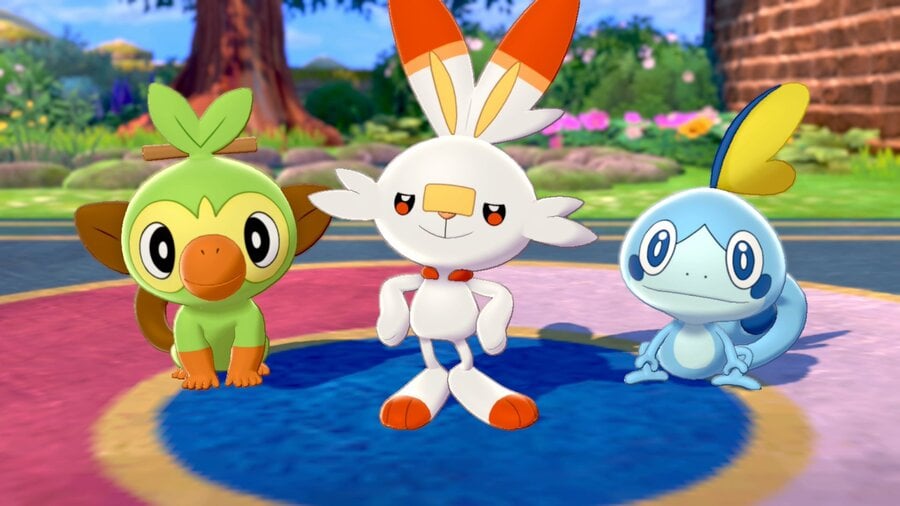
The rest of the designs are arguably among many of the best Pokémon has delivered in a while, and alternate forms were used throughout. Alcremie is a Pokémon based on whipped cream and comes with over 60 different forms based on its flavour and the sweet used to evolve it. Cramorant is a fan favourite with special forms that have it eating an Arrokuda or Pikachu, depending on the health when the form is activated.
This generation also reintroduced a concept that, Sylveon aside, had been gone since 2006; evolutions of old Pokémon. Primarily this is done through evolving regional variants of Pokémon, but with Pokémon Legends: Arceus, several that evolved straight out from older Pokémon were introduced including Wyrdeer, Kleavor, and Ursaluna.
Following the massive amount of Legendary Pokémon in Generation 7, Generation 8 pulled back a bit and started off with just the two heroes of Galar, Zacian & Zamazenta, and the mysterious Pokémon used by Rose to bring on the Darkest Day, Eternatus, with all three having moves that do increased damage against Dynamax Pokémon. The DLC and future games changed this further. The DLC introduced nothing but Legendary Pokémon which tied in to the stories of each DLC pack, and even introduced Regional Variants of Legendary Pokémon. Pokémon Legends: Arceus then followed up by adding yet another Legendary Pokémon, Enamorus which is a fourth addition to a Legendary trio introduced in Pokémon Black & White and even has a Therian Forme.
Mythical Pokémon were very few in this generation, presumably due to the lack of movies. The only new Mythical Pokémon introduced was Zarude, a Dark/Grass-type Pokémon that inhabits the jungle. It even has an alternate “form” of Dada Zarude, a Zarude with a Celebi cape as seen in the movie, Secrets of the Jungle. This generation also gave a Gigantamax form to the mythical Pokémon Melmetal.
Generation 8 really upped the game in the notion of unique Pokémon. From possessed teapots to hungry squirrels, there were new Pokémon for everyone.
The Anime
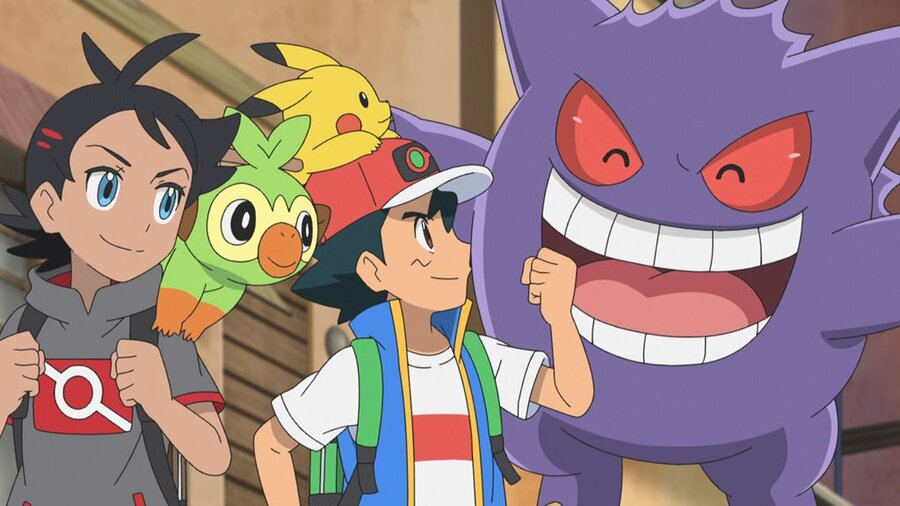
Following the slice-of-life anime style of Pokémon Sun & Moon which had Ash win his first-ever league, the anime shifted to a mix of adventure and slice-of-life with what was known in Japan just as Pokémon, and in the West as Pokémon Journeys. This series changes expectations and, rather than just explore the Galar region, it focused on every single region and had the most continuity of the Pokémon anime with many of Ash’s old friends, enemies, and acquaintances returning.
This series had Ash become a research fellow at Cerise Laboratories alongside a new trainer, Goh. Goh met a Mew long ago, made finding the Mythical Pokémon his goal, and decides the way to that goal is to try and catch every single Pokémon there is.
Ash also finds a new focus with the Pokémon World Coronation Series after first meeting Leon in Galar. Deciding to join up, Ash rises through the ranks battling Gym Leaders and old friends to reach the Masters 8 to join the final tournament against various champions from across the world to see who is the World Coronation Series champion.
As the main anime had a specific focus, and following the success of Pokémon Generations, several web anime series were introduced.
The first was Pokémon Twilight Wings, a short series set specifically in Galar. Each episode focused on a specific Gym Leader of the region and provided insight into their past.
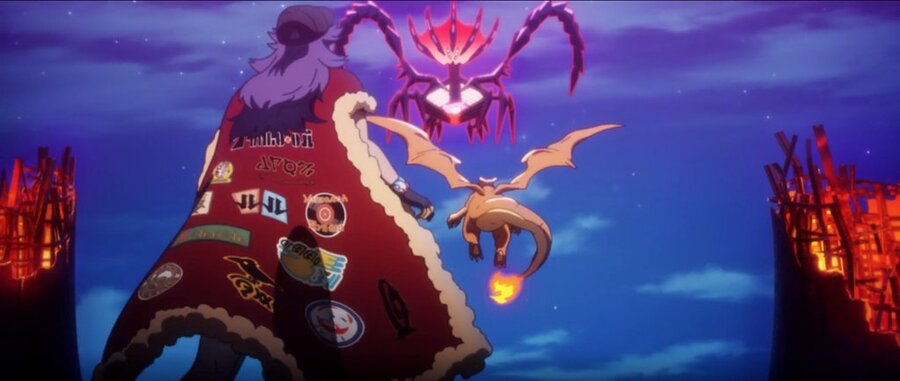
Pokémon Evolutions was the spiritual successor of Pokémon Generations and had an episode based on each region of the main series, featuring a retelling of various story elements including Leon’s fight with Eternatus, Barry fighting Team Galactic in Lake Acuity, and more.
Pokémon Hisuian Snow was created by WIT Studio and was a three-episode tie-in with Pokémon Legends: Arceus. It focused on the original character Alec and showed his first trip to Hisui as a child and when he returns years later.
Finally, PokéToon is a collection of shorts from various different animation studios in Japan and is now releasing on Pokémon TV. It tells various touching stories related to humans and Pokémon.
Movies
This generation was unique in that it has only had one movie. Due to the global situation, this movie got delayed from the traditional July slot in Japan and then took a year to make it through to the West.
Secrets of the Jungle featured Ash meeting a boy called Koko. Koko was raised by a Zarude after the Zarude found it as a baby. Koko grew up thinking he was a Pokémon and eventually found the truth when scientists who worked with his parents started to hunt down the Heart Tree at the heart of the jungle where the Zarude lives.
Spin-off Games
After the bulk of Generation 7 and the latter half of Generation 6 were predominantly mobile, the spin-off titles started to shift with more of a console focus, though some games were available on both console and mobile
Console
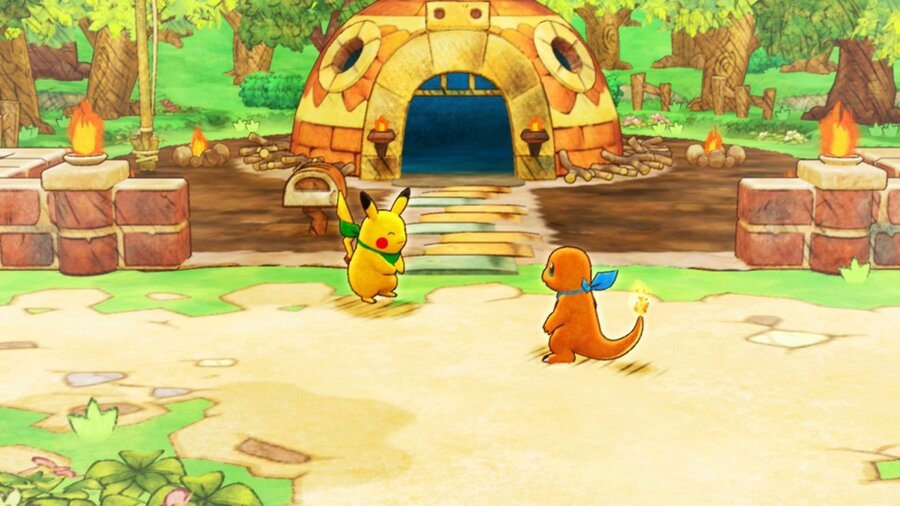
At the start of the generation was Pokémon Mystery Dungeon: Rescue Team DX. This game was a full remake of the original Pokémon Mystery Dungeon games on the GameBoy Advance/DS and featured a 3D graphical style that matched the artwork of the games. Only the first 386 Pokémon and any evolutions they had were available in the game, and it included Mega Evolution for the first time.
After over 20 years of people wanting it, in 2021 a sequel to the Nintendo 64 classic, Pokémon Snap, was released. New Pokémon Snap expanded on the concept adding various new stages with branching paths and hundreds of Pokémon to interact with. It featured online leaderboards and showcases so you could show your best photos around.

Console & Mobile
Pokémon Café Mix was released in June 2020 and was a continuation of the concepts set by Pokémon Trozei, Pokémon Battle Trozei, and Pokémon Shuffle and has you complete stages by clearing puzzles, with each stage having specific requirements for completion. As you complete stages, you create dishes to give to various Pokémon, with the hopes to recruit them as staff. The game then got upgraded in 2021 to Pokémon Café ReMix, acting as a soft relaunch of the game with more features.
Pokémon UNITE released in 2021, developed by TiMi Studios. This free-to-play title is a battle arena game where between three and five players join a team and battle against another team. You collect points by defeating wild Pokémon and other players, and have to score them. After the time is up, the team with the highest score wins. It gets routine updates adding more Pokémon and outfits. It has since joined the Pokémon World Championships as of 2022.
Mobile
Pokémon Smile was released in 2020 as a simple mobile game to teach children to brush their teeth. In it, you catch Pokémon simply by brushing your teeth efficiently. Over time it has received updates including a recent addition of Johto Pokémon to the game
Pokémon GO continued on through the generation, adding Pokémon from even more regions, now with Pokémon from every generation within it including Pokémon from Sword & Shield and even Legends: Arceus. Over the generation, it had to adjust to the new world circumstances brought about by the COVID-19 pandemic and allowed for players to play raids remotely, participate in events remotely, and more.
Pokémon Masters EX released right at the end of Generation 7 and has had continual updates ever since. It has added more trainers, known as Sync Pairs, from all regions of the game from Kanto through to Galar.
Pokémon Trading Card Game
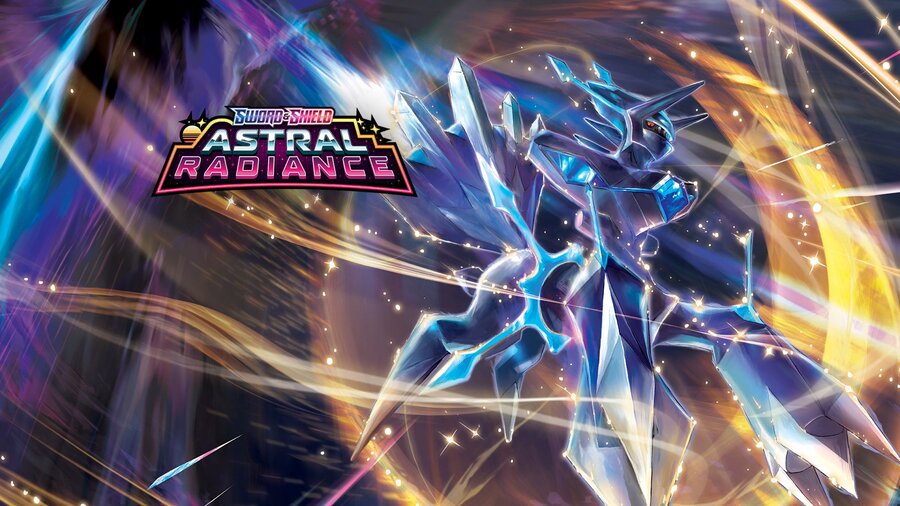
The Pokémon Trading Card Game has continued on throughout Generation 8. Removing Pokémon GX, it introduced a new concept, Pokémon V, which acted in a similar manner in having high HP and strong moves, but they went even further with the addition of Pokémon VMAX, which are the TCG’s equivalent of Dynamax. This increases the Hit Points further but the opponent gains three Prize Cards if they knock it out.
Pokémon V expanded even further as the generation went on. Pokémon V-UNION cards had you have to play four pieces of a card from your discard pile in order to use it on your bench. These cards are very powerful but the means to get them played mean they have not seen much use in competitive TCG play.
Pokémon VSTAR are the latest addition and act as an amalgam of Pokémon VMAX and Pokémon GX. They have increased damage and Hit Points but have a special move or Ability, the VSTAR Power, which you can only use one of per game between all VSTAR Powers in your deck.
The Pokémon Company has also introduced a successor to the wildly popular Pokémon Trading Card Game Online in the West. Pokémon TCG Live is its successor and is coming to PC and Mobile soon, with beta available at time of writing in Canada and Mexico.
Competitive Pokémon

The Pokémon Championship Series hit a stall with the global situation and the Pokémon World Championships in both 2020 and 2021 got cancelled.
During the interim, they kept things going with the Pokémon Players Cup online events for VGC, TCG, and occasionally Pokkén Tournament DX, and the Draft the World tournaments for the TCG. The Pokémon Company also held several events in Japan, and Pokémon Korea held the Pokémon Trainers Cups and other events in the West.
It was then announced that 2022 would be the return to live events, with Regional Championships coming back in March 2022 towards the 2022 World Championships. For the first time, Pokémon GO and Pokémon UNITE were added to the circuit making there be five games in the Pokémon World Championships.
A Look to the Future
While the generation started off with the community imploding due to the lack of all Pokémon in the games, in many ways Generation 8 was one of the strongest generations. From a business perspective, the games sold the best for decades, the TCG has sold over quarter of its total card amount in just these three years, spin-off games on dedicated devices have returned to high acclaim, and multiple web anime series have come. The Pokémon Company has been trying a lot of new concepts in this generation, and they don’t look set to stop experimenting.
While there are still some unreleased projects that we know about, notably Detective Pikachu 2 on the Nintendo Switch and Pokémon Sleep on mobile, as we go towards Generation 9 and Pokémon Scarlet & Violet, we have to wonder just how much momentum will carry over, if these new ideas will continue.
How will Pokémon GO, Pokémon UNITE, and Pokémon Masters EX adapt to the 9th generation? Will movies return? Time will tell, but let us know your thoughts below on how Generation 8 ran and what you hope will come in the future.
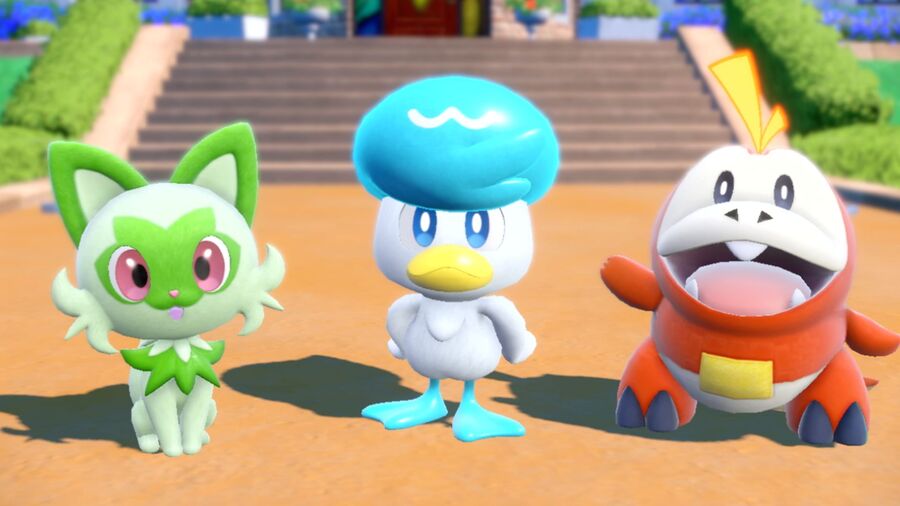





Comments 49
It took me two years to buy Shield version because I was too upset at all the missing Pokémon that it took the wind right out from under my enthusiasm.
I actually like Galar way more than Kalos or Alola (but not as much as any of the pixel era regions from before them), but damn, I just can't get over the lack of a full dex in Pokémon games going forward. It's tragic.
Honestly an underrated generation. There were a lot of complaints about the story not being great, but I loved the simplicity of it and the new Pokemon designs.
I remember being upset about the lack of a full Pokedex, but let's be real, I didn't need to use Beedrill for the 8th time. And I ended up finding new Pokemon I would have never picked, so all's well that end's well.
Wild Areas are a great addition to Gen 8. The actual cities and routes are very barebones, however. The story is meh until close to the end. I think the battles with Chairman Rose and Leon are pretty good as are the battles against the title legendary and Eternatus. Despite this, I'd put Gen 8 close to the bottom. I'd argue only Gen 6 is worse.
The god awful thing about gen8 was that they treated you like a 3 year old child. They had 6 different npcs tell you the same thing one after another just to make sure you dont miss the one single road this game has.
One of the worst for me. There’s no fun in avoiding all the Pokémon you already have. And the “open areas” were crappy as all hell. That was the worst aspect of it for me. I remember GF calling it the first “open world Pokemon” and “areas as big as a third of BotW” …. Yeah… right.
And ohh… the grinding on those Dynamax thingies was ATROCIOUS. Waste of time.
Arceus was splendid and superior in every single way. World design and at least it gave you a reason to capture your 30th Zubat for the 100th time, instead of avoiding everything you see except for the new Pokemons.
I really wish GameFreak learns a lot from that going forward.
I do not regret skipping this gen (or pokemon altogether) in the slightest. To this day it reeks of laziness and greed especially with them selling base game content back to you as DLC.
So...a retrospective that ignores criticism and is just a highlights reel. Almost like those product "reviews" that highlights product features and barely addresses anything that is worthy of a review.
Yes the bashing and harassment was not acceptable in any way. But ignoring that these games had quality issues would be disingenuous to readers. BDSP has many issues ranging from glitches, a lack of features from Platinum, to bad concepts that were fixed in Platinum. Like having to see every regional Pokémon before going to the Battle Zone or getting the national dex. So if you picked the wrong answer at Fantina's gym and missed Drifloon, you'll have to wait and encounter one next Friday. Or that the game was given forced exp share despite having the exact same levels from DP....and then gave the Elite Four maxed out stats. Meaning most people only got through it due to the friendship mechanic giving them the win. It's a terribly balanced game.
Then we have SwSh with hallway designs, barren overworld, and the villains being undercooked. But no mention of that at all. What point is there to a retrospective if it doesn't cover everyone's opinions or at least considers the good and bad?
The generation that marked my modern shift with Pokemon. SwSh came out when I was entering my mid-teenage years and it was really the point where I began to take Pokemon as a game a lot more seriously. I had played every game since Black/White and loved them, but I wouldn't usually do too much after beating the game besides exploring and filling out the dex. Thanks to SwSh's massive regional dex, close to home region and ease of getting competitive Pokemon ready though, I was (and still am) heavily addicted to each and every one of it's gameplay loops. It is to date the most time I've put into a single Pokemon game to date (485 hours currently) and I don't want to stop anytime soon.
BDSP then came around much later and I had a great time with that as well. As someone who started the gen after 4, getting to see what all the buzz was about it was a magical feeling (especially with the remastered tracks and little extra details tossed in here and there as well). The artstyle is still weird but I got used to it in due time (poor Cyrus) and it has TO DATE my favourite playthrough team ever. Loved these ones a lot as well.
And finally, most recently, Legends Arceus. This was the first time I had ever gone into a Pokemon game fully blind, not even looking at gameplay previews so as to not spoil how the game played, and it was utterly magical. Connecting the dots with the ancestors, hearing the extra flourishes of Gen 4 in the music, the completely unexpected turns the story took and discovering new Pokemon I had never heard of before for the very first time (I'll never forget seeing Ursaluna and Arcanine for the first time). And who could forget about ******* INGO, far and away the most interesting character since bloody Anabel and Looker. The new gameplay was the cherry on top as well, mixing action adventure elements with traditional catching/battling to create the most satisfying Pokemon game ever made. It's absolutely in my top 3 Pokemon games ever now with BW and SM for damn good reason, this game was a masterpiece from top to bottom.
Overall, a banger gen that makes me monumentally hopeful for Scarlet and Violet and the adventures that'll naturally come along with it!
Oh and I know you probably won't read this, but thank you so much for everything on Serebii Joe. I've used it since I was little and it's been by far the best place for looking for Pokemon info on the entire web
Pokemon Sword / Shield was okay for me, at least felt better than Sun / Moon on 3DS.
The only thing I don't like was the "soccer" vibes from the outfits you wear when entering gym leader stadium as I clearly don't like soccer at all (since generation 8 was based on UK) and I felt uncomfortable to deal with soccer things.
I liked Pokemon Shield for what it was, plus a new Pokemon Snap game was always going to have my interest. Pokemon Legends: Arceus, came out at the perfect time (right as I caught Covid, not that that is a good thing), so I was able to make that my main focus, while I was staying home.
Also, Brilliant Diamond was fun as well.
This entire generation (among others) felt like a game dev/design experiment.
Pokémon Sword and Shield weren’t terrible or anything… but they were underwhelming and felt underbaked. They were probably my least favorite main series games to date besides the Let’s Go titles.
That said, the DLC was surprisingly very good. The more open-word nature and less hand-holding design really made the DLC worth playing.
Then we got Brilliant Diamond and Shining Pearl. Despite a lot of disappointment from the community, I actually very much enjoyed them as a comfort-food style game. If ILCA is given more time and tries a few more interesting things, I’d be more than happy to have them handle the future of the more traditional, “2D” games.
Then Legends Arceus came out and blew me away. I wasn’t even hyped for the title at all. I was cautiously looking forward to it. Sure, the visuals are still a bit rough and you cannot battle online. But the core game itself… it’s incredible. This was the step forward the series needed and I’m glad to see Scarlet and Violet incorporating some of the elements from the game.
Overall, I was disappointed with Let’s Go and Sword/Shield. Then the Isle or Armor/Crown Tundra ended up being fun, BD/SP were very enjoyable comfort-food titles for me, and Legends actually impressed me. Pretty big 180 for me, personally.
What a fantastic read! I had no idea these Pokémon retrospective articles existed. Great article and I'll be reading the other 8 over the weekend! Kudos Nintendo Life 👍
@DeathByLasagna I personally find Pokemon games as a whole to be very much 'comfort food' gaming, you know? It's the series that whenever I go onto it, I know I'm going to have a great time. For example, I'm playing through Let's Go Pikachu as we speak (about to take on the last Gym) and it was a game I had skipped originally for not being the Pokemon game I was used to. However, after getting the fresh yet familiar (SwSh), the traditional (BDSP) and the wildly experimental (PLA), I decided to give it a go with the knowledge now that just because it's it's own thing doesn't make it worse and, sure enough, I've been having a blast catching anything and everything I see. Pokemon is just the most relaxing game series for me personally (aside from maybe Picross, that stuff is my absolute jam).
Didn’t like SWSH at all, but Legends Arceus was a great game with inexcusably garbage graphics.
This generation really feels like the turning point in the series for me. After years of mediocre linear Pokemon games that were heavily casualized and lacking in content like the Gen 6 and 7 games (also Gen 5 to a lesser degree), they really seem to be pulling a 180 and opening things up and modernizing them for a more console audience. And I believe they've set the groundwork for even greater things to come in Gen 9 (we already know this is true to some degree, as SV are already confirmed to be fully open world games where you can explore areas in any order and we can explore them in 4-player co-op). TBH, I was really questioning quitting this series over the direction that Gens 5-7 were taking the franchise, but now I'm excited for this series once again. It's not without its issues (see: Dexit), but in general I think Pokemon is headed back in the right direction.
And honestly I think we have BotW to thank for this. Gens 5-7 seems to have been designed under the assumption that dedicated handhelds/consoles would die out and that mobile would be the go-to market for video games. Game Freak even admitted that they thought the Switch would fail. But then the Switch came out and BotW was an insane success both critically and commercially that Game Freak wants their own BotW now and the changes we started seeing in Gen 8 and into Gen 9 are a direct response to BotW's success. So that really leads me to think, if not for BotW Gen 8 would probably be more like Gens 5-7 and I'd probably have left the series by now. Thankfully that didn't end up being the case.
Gen 8 is right up there with Gen 2 and Gen 5 among my favourite generations. Definitely felt like a return to form for me after the rather lackluster 3DS games
SwSh is actually my favorite game in the series. Competitive is amazing, the new Pokémon designs were awesome, and the DLC added more than any third version ever did. Shout-out to raids, raid events and dynamax adventures. Me and my less competitive inclined friends played it for a very long time, still do
I never thought I would play a Pokemon game that would leave such a horrible taste and making me genuinely angry after playing it.
The dumb-as-bricks NPC's in the Dynamax battles, muddy low-res textures, insanely bad in-game cutscenes and presentation and the dirt-poor battle animations. All those things makes Sword & Shield one of the absolute worst videogames I have ever played in my life.
Hopefully Scarlet & Violet can remove the horrible stench that Sword & Shield left behind.
For me Gen 8 has to be the most underwhelming gen so far and has made me lack confidence in the brand. This was a problem that began in the middle of the 3DS life cycle with Gen 7 that came full circle in Gen 8. Aside from Arceus which I found a nice change the rest of the gen disappointed me. BDSP are poor remakes that shouldn't have released in the state they were and were so inconsistent trying to be faithful to an inferior version when Platinum existed. Sword and Shield felt barebones just like XY and yet XY still felt it had more and so far Gen 9 hasn't done anything to get me excited. I use to be so excited by Pokemon games and since 2014 that has just been doing downhill for me. It's sad to see a series that I once loved so much as a child that ignited my love for games go down the path it has. I would love for Gen 9 to prove me wrong and give me that same passion I had before but it's feeling unlikely. I think I'm best sticking to series like Persona, Shin Megami Tensei, Digimon and other RPGs that provide me with what I've hoped for Pokemon to do.
Personal opinion: worst generation so far. I play Pokémon since 1999.
This generation made me have low expectations for the future of the series.
Legends: Arceus was ok, but was also rushed nevertheless.
Seems like Game Freak don't mind polishing their games anymore (as people are buying anyways).
@RubyCarbuncle

I feel like Sword/Shield are some of the most over hated games in recent memory. Personally, I really enjoyed my time with Shield and its DLC. Can't wait for S/V.
Regardless of the experience with the games, I feel that 2019-2021 was one of the most trying periods to be a Pokémon fan or engage with the community.
I bought Blue on day of release and I’m still having fun.
-BDSP- Were they safe remakes? Sure. Did I enjoy them? Yes. It was nice to go back to the traditional 2D style. Grand Underground was enjoyable for a change. I hope ILCA do future remakes and are allowed to expand upon them.
-Legends: Arceus- It was...fine. I didn't enjoy it as much as others. To me, filling out the Pokedex always felt like a post-game activity, not a main quest. I also found it missing some of the charm the traditional games had. I felt like I didn't have much chance to build a team or have any connection to them due to having to change the squad regularly. It felt like a chore at times. I think I gave up on the side quests after a while. I also got fed up of being preyed on by alphas and being bombarded in time distortions. It had some good ideas such choosing your lead pokemon with a press of the shoulder button and the option to evolve select Pokemon with items as opposed to trading.
All in all, I liked the games that people disliked and didn't enjoy the one others liked. I'm like....the opposite of the average Nintendo Life commenter here. Oh boy, I'm going to get angry comments on this, aren't I?
Sword and shield was alright. It got a lot of hate but as always I find myself enjoying that more than hating along with everyone else. The youtube content that comes out of it is just too fun to watch to mind, hehe. Besides, the games were fun, though rather bland and boring.
Skipped the BDSP remakes, atrocious excuses for remakes, especially compared to the platinum version all the way back on the DS. For those that haven’t played those Ds titles though, probably more than fine so I’m glad people get to enjoy Diamond and pearl that way.
Legends Arceus somehow had me putting hours upon hours into the game, in a way no pokemon game ever has before, catching them all for the very first time. I love that game and though I see a lot of room for improvement, that just has me hopeful for the future of pokemon for the first time in a looong while.
I also somehow got stuck into the trading card game and enjoying that a lot.
Yep, hopefully good times ahead for pokemon, no matter what anyone else might say. I guess I am totally a part of the problem, but hey, feels like half the world is part of it so I don’t mind rolling along if I get fun, comfortable gaming experiences : P
As someone above me mentioned, pokémon kind of feels like comfort food.
If this gen had ended with SwSh and BDSP, I'd feel safe calling it the worst one in the series. After all, SwSh's wild area implementation was a mess, it gutted the multiplayer features for people who don't want to deal with Pokemon Home, and it features one of the worst story campaigns in the series; as for the Gen 4 remake... well, lazy doesn't begin to describe it.
But Pokemon Legends is splendid. Not perfect, but it's the most interesting Pokemon game I've played since X & Y, IMO. Totally the shot in the arm the series needed.
We'll see how Gen 9 pans out.
Sword and Shield were the most fun I’ve had with Pokémon in a long time! We’re they perfect? No. But were they great where it counted? For me, absolutely!
I loved nearly all the new Pokémon and regional variants, and there was plenty of them which is the biggest thing for me. And the biggest let down of X&Y prior.
Dynamax was, for me, way more fun than Mega evolution. The limited move sets were not great I will grant, but the fact that any Pokemon could do it felt great! And if they Gigantamaxxed that was just an added bonus! It was simple but combined with the atmosphere of the gym battles it felt super cool to do! A much more interesting gimmick than those of Sun & Moon’s gyms. And it didn’t result in everyone having the same team again or make you jump through hoops to get specific items for each Pokemon.
I liked the reduced dex. Honestly it doesn’t make sense every region has the exact same wildlife plus some more each time anyway! And with regional variants we need this even less now. It was the first time since Blue I have actually completed the dex, or even felt that possible!
And so few legendaries! Great! Legendaries aren’t legendary when they’re a third of the new Pokémon… and you can’t just called them Ultra Beasts and claim it’s different! And they felt fittingly tied into the region, too. Not just a crazy powerful thing that happens to live here I believed they could be the legends of Galar, same with Calyrex in the DLC.
People are gonna hate it. I know if your fav was cut that sucks. I know if you like all the post game there isn’t as much. But there’s a reason they’re the second best selling - because they’re a fantastic edition.
@Ogbert Every region doesn't have the same wildlife, though. The issue was never "I can't catch all of the Pokemon in this new region." The issue was that you can't import hundreds of Pokemon from previous entries.
It's like Galar has this weird, arbitrary list of banned Pokemon that you're not allowed to even enter the region with.
@YoshiF2 Gamefreak estimated that the wild area was the size of two of Breath of the Wild's map regions actually, but still a terrible estimate.
Generation 8 will go down as the Pokérenaissance.
This one was really rough
@LXP8 yeah... I remember there were a ton of lies leading up to the release. I didn't care about Dexit since I have many Pokes in Home.... but the other stuff ... that I DID care about the lies. Open world my ***. Talk about small areas and linear, short hallways. And those god awful 1 meter sudden spawning.
This ones not making me come back to pokemon
Great retrospective . I'm ready to move on to Gen 9
Switch era pokémon. had its flaws (a lot of them) but it has undoubtedly been a high-point for the franchise. The criticisms i've seen are valid but in my opinion overlook howmuch the pokémon co has done right in recent years
In case anyone is wondering, the reason I say "switch era pokémon" and not gen 8 is because of how arbitrary the definition of generation has become. It's getting harder and harder to draw any meaningfull line between one generation and the next.
We've had more variety, innovation, and batches of new pokémon over the past four years/games than we had over the first four generations. Maybe it's time to uncouple the identity of games from the generation they're released in while treating each entry as a continuation of what came before.
@Dilly-Mick While it's true that Pokemon games are becoming different from each other even within the same generation, I don't think LGPE really contributes to the innovation (at best maybe the overworld spawns are closer to the bold, experimental changes we saw in Gen 8, but that's about it) and really seems to be more characteristic of the 3DS era game design philosophy, heavily linear and casual to attract a mobile audience. LGPE feels like the culmination of that philosophy in fact, since they literally adapted mobile mechanics with the intent of drawing in Go players from mobile. A lot of the innovations have really been related to the transition to open world gameplay that will finally be completed with SV, and as I said in one of my previous comments, this mainly seems to have been spurred by BotW's success and does not seem to have been in their original plans for Gen 8. So without LGPE, Gen 8 is specifically when these innovations have arisen as all Switch Pokemon games so far have been Gen 8 games. This will change with the impending release of SV, but we don't know for sure if Gen 9 will continue that legacy (we know that SV will on some level, but we can't really judge the generation very well just based on one game that we still don't know that much about yet).
Worst gen in the series next to X & Y
@Ralizah you’re role playing a character from Galar, they don’t need to have the same Beedrill you’ve had since role playing a different person in Red & Blue. Just play with the new Pokémon and I’m sure a bunch that aren’t in this one will be in the next. Or just keep playing the same old games that have the team you like.
The story is basic and formulaic and always has been, the gameplay is much the same as it’s always been even with the additions and improvements. If you’re not here to catch and train new Pokémon what are you here for? Even if you had the perfect Beedrill for competitive play and now you can’t use them, you should probably mix up your strategy anyway to combat all the new Pokémon and training a new one should be fun (and it’s much easier now).
Some of my favourite Pokémon were not in Sword and Shield and I still count it as one of my favourite entries, maybe my top entry in the series.
And all the post game stuff don’t get me wrong, I hope they add all that back in for those that want it. But the reduced dex was absolutely fine for me, and the trees didn’t look so bad either.
@Bolt_Strike your opinionated conclusions notwithstanding, my point still stands that, arguably, starting as far back as USUM if not LGPE, the old patterns are being deconstructed and it's making less and less sense to group all the mames of a "generation" together as if they have some sort of meaningfull unifying identity, that seperates them from the previous and upcoming generations.
If you go through the history of the page "generation" on bulbapedia the definition keeps getting increacingly broad as each new gen added an exception to the rule, even as far back as gen 5 and continuing up until now. (In fact, strictly going by the current bulbapedia definition, legends arceus is Gen 9... Oh sorry no, it didn't add any new abilities, because there weren't any but neither did gen 2 because there weren't any... So really we've ben counting gens wrong this whole time!)
@Dilly-Mick Just read that Bulbapedia article and that part was not a definition of what a generation is, it simply says that new generations do that.
Also Legends Arceus does not fit that "definition" because it did not introduce a new region, it takes place in Hisui which is just past Sinnoh. It's called a different name, but it's still the same region.
I will agree with your overall point though the definition of a generation is getting looser and looser. We used to say it was defined by new Pokemon... until USUM started throwing in new Pokemon mid-gen. We used to say it was compatibility, but LGPE aren't really compatible with the other Gen 7 games and because of Dexit we can't really communicate with other games directly either.
That being said, I do think we can easily identify what a new generation GAME looks like (i.e. a game in the vein of RB, SwSh, etc.) and right now that's defined by the following:
-Takes place in a new, never before seen region (this is true for all new gen games, even GS which while it did have you go back to Kanto, also you play through Johto which was a new, never before seen region)
-A large batch (more than 10, but so far all new gens have had at least 50) new Pokemon, including completely new species of starters and a completely new species of box legendaries (note that this is also different from Arceus, where the starters were existing species that had new regional variants and there were no box legendaries and the legendaries that were key parts of the story were old legendaries that have existed since DP).
And I don't predict most if any of this changing, it's done that way to make it feel new and highly marketable and switching that up probably won't benefit them.
@Bolt_Strike
gamefreak has made it clear they see Hisui as culturally and geographically distinct from Sinnoh. They might not be seperated by space but they are seperated by time. If you believe one is greater than the other I suggest you go talk to the diamond and pearl clans. We could just as easily argue Johto is an annexation of Kanto.
And so yes, we can define a "generation-starting game" by the one arbitrary trait the games we the fans designate as such have in common but what doesit mean to "start"a generation if the definition of "generation" itself is meaningless?
All we're doing is trying to force the application of obsolete terminology on an evolving franchise, without asking ourselves if we have any reason to. Give me a meaningfull definition of generation and I will happily concede this point.
@Dilly-Mick Adaman would get quite a kick out of the Ship of Theseus, but I digress.
I remember when everyonevwas outraged that gamefreak hinted meltan would be a gen 8 pokémon despite making a minor appearance in a gen-7 "spin off" and had a predominant role in the sun and moon anime
Munchlax, a gen 4 pokemon:
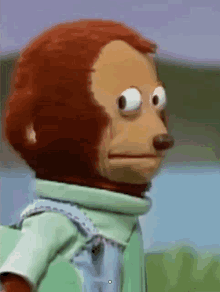
@Dilly-Mick I've come to see 'generation' as simply a demarcation between the regions that take the main focus of the core series games. Though you could argue that 'generation' has been meaningless since the jump from Gens 4 to 5 since there was no hardware change between them. I don't think anyone can really say for certain what it means anymore.
@Maximumbeans and that's completely fair actually (even if galar taking the main focus is highly debatable)
My real issue is the the "demarcation" you speak of is becoming increacingly arbitrary. Which, in of itself wouldn't be an issue except the continued use of the terminology tends to skew our perspective of newer games.
Trying to compare the "merits" of a new gen with an old one is apples and oranges. The switch era of pokemon is arguably defined by experimentation and variety. Lumping three games together as "gen 8" and assessing them as a general whole, can similtaniously obscure the "big picture" and lead one to asses one game based on an experience with an entirely different one. (I'm not saying that as a hypothetical either I'm speaking about what I've observered in conversations both here and elsewhere)
@Dilly-Mick See that's another reason Gen 8 is a different beast: I'd say past generations focused more on the 'core' region, but this time we've been paying a lot of attention to Sinnoh and Hisui so Galar has suffered, like you say.
I completely get what you mean – the franchise has just become too busy to be contained like that for much longer, especially now we have stuff like Legends mixing things up even harder.
Let's be honest, the whole 'generation' thing started suffering when Pokemon Ranger got filed under Generation 3 despite being on the DS and releasing just a few months before Diamond and Pearl. It's all a bit weird.
Yeah you get what i'm saying, thank you.
In fact if we really want to deconstruct the significance of classifying games by generation we can say the line between gens was already blured as far back back as gen 2 by fliping our logic arround. While we now have so much change within a gen, back then there was so little change across gens.
Sure Jotoh added 100 new pokèmon a new region and color but strip that away and it had about as much in common with the 1st gen games as USUM had with SM. (It's not a direct comparison but I think the pount still stands) and that's trans-media too. The anime, manga, cards all just seemlessly blended from one issue to the next in a way we've never really seen since.
Show Comments
Leave A Comment
Hold on there, you need to login to post a comment...